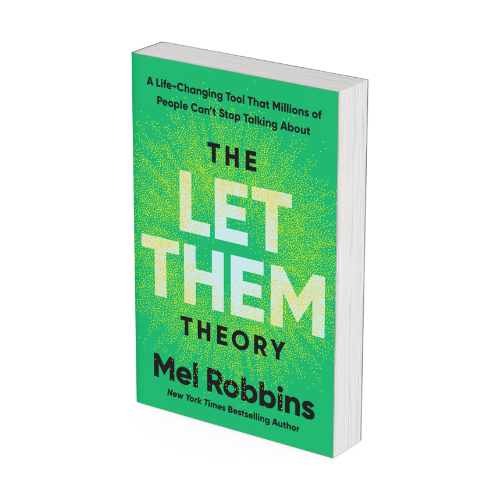The Let Them Theory
by Mel Robbins
Mel Robbins is a well-known motivational speaker, best-selling author, and former criminal defense attorney. She is most famous for her practical and direct advice that helps people take control of their lives without relying on hype or fluff. Mel doesn’t complicate things. She speaks like someone who has been through real-life mess and came out the other side with something valuable to say. Her earlier books, like The 5 Second Rule, show her consistent style: clear, no-nonsense strategies that can be used by anyone trying to make meaningful change. She is also known for her viral videos and popular podcast where she breaks down life’s challenges in a very human and relatable way.
Summary of The Let Them Theory
The Let Them Theory is Mel Robbins’ way of challenging one of the most exhausting habits we all fall into: trying to control what other people think, say, or do. The core idea of the book is exactly what the title says. When people behave in ways that bother you, disappoint you, or make you feel rejected or judged, let them.
Instead of getting tangled in emotional drama, chasing validation, or micromanaging relationships, Mel offers a new perspective. Let people be who they are. If someone doesn’t invite you to a party, let them. If they talk behind your back, let them. If they choose not to support you or don’t like your choices, let them.
The book is filled with real-life stories and examples that show how much energy we waste trying to control what isn’t ours to control. Mel connects the dots between our people-pleasing habits and the anxiety or burnout many of us feel. She also shows how letting go of that control creates freedom—not just for others, but for ourselves too.
This isn’t about giving up or disconnecting. It’s about acceptance and clarity. When you stop trying to force things or fix people, you learn to stay focused on your own values, needs, and peace of mind. Letting them do what they’re going to do gives you space to live your own life fully.
My Thoughts on The Let Them Theory
I’ll be honest. This is one of those books that’s frustrating at first, because it hits too close to home. We’ve all been in situations where we felt the urge to argue, convince, prove a point, or win someone over. And Robbins just looks us in the eye and says, “Why? Let them.” And at first, it feels like she’s telling us to be passive. But she’s not. She’s telling us to be free.
This book is not for people who love drama or feel comfortable playing emotional tug-of-war. It’s for people who are tired of that noise. Personally, I found the book like a cold splash of water. A bit uncomfortable, but very necessary.
You’re going to grieve some relationships.
I liked how Robbins didn’t sugarcoat the fact that letting people go, or letting them be, is going to be painful at times. You’re going to grieve some relationships. You’re going to realize how much energy you’ve wasted trying to please people who were never going to be pleased. But in the long run, this process creates real peace. The kind of peace that comes when you stop trying to manage other people’s reactions.
As someone who works with clients around relationships, boundaries, and emotional health, I saw the immediate usefulness of this theory. There’s nothing new about “acceptance” as a concept, but Robbins finds a way to explain it that cuts through the noise. She’s not trying to be spiritual or soft. She’s being real. And that’s what makes it land.
Also, I appreciate how she connects this mindset shift to better decision-making. When you stop obsessing over what others think, your choices become clearer. You know what you want. You know what your limits are. And you stop betraying yourself just to be liked. That’s powerful stuff.
I Encourage Clients and Colleagues to Incorporate the Teachings from The Let Them Theory
Here are the practical takeaways I believe clients and fellow therapists or coaches should apply from this book:
Stop controlling what isn’t yours to control
People are going to talk, judge, exclude, or disagree with you. That’s their right. Let them.
Let go of people-pleasing
You’ll never be able to please everyone. Trying only exhausts you and waters down who you are.
Boundaries are not walls
Saying “let them” doesn’t mean you don’t care. It means you value your own peace and priorities more than approval.
Clarity comes from detachment
When you let people show you who they are, instead of trying to shape them, you see the relationship clearly.
Don’t argue with reality
If someone doesn’t want to stay in your life, or doesn’t agree with you, let them. Holding on only makes things worse.
Use “let them” as a mental reset
When you feel the urge to fix, chase, or prove, say to yourself: “Let them.” It brings you back to center.
Letting go isn’t cold—it’s courageous
It’s a mature, grounded act. You’re choosing to stop wasting time on people and things that don’t align with your values.
Model this for your clients
Show them what calm, boundary-based living looks like by practicing “let them” in your own life. They’ll feel the difference.
In Summary
Mel Robbins’ The Let Them Theory is a practical guide to emotional freedom. It reminds us that peace doesn’t come from controlling others. It comes from letting go. If you’re ready to stop wasting energy on what you can’t control, this book delivers the mindset shift you need.
The Let Them Theory
by Mel Robbins
About The Author
Mel Robbins is a well-known motivational speaker, best-selling author, and former criminal defence attorney. Additionally, she is most famous for her practical and direct advice that helps people take control of their lives without relying on hype or fluff. Importantly, Mel doesn’t complicate things; she speaks like someone who has been through real-life mess and emerged with valuable insights. Furthermore, her earlier books, such as The 5 Second Rule, demonstrate her consistent style: clear, no-nonsense strategies accessible to anyone seeking meaningful change. She is also widely recognised for her viral videos and popular podcast, where she breaks down life’s challenges in a relatable and human way.
Summary of The Let Them Theory
The Let Them Theory is Mel Robbins’ way of challenging one of the most exhausting habits we all fall into: trying to control what other people think, say, or do. Essentially, the core idea of the book is exactly what the title suggests. When people behave in ways that bother, disappoint, or make you feel rejected or judged, simply let them.
Instead of getting tangled in emotional drama, chasing validation, or micromanaging relationships, Mel offers a refreshing new perspective. For example, let people be who they are. If someone doesn’t invite you to a party, let them. Similarly, if they talk behind your back, let them. If they choose not to support you or dislike your choices, just let them.
Moreover, the book is filled with real-life stories and examples demonstrating how much energy we waste trying to control what isn’t ours to control. Mel connects the dots between our people-pleasing habits and the anxiety or burnout many of us experience. She also shows how letting go of that control creates freedom—not only for others but for ourselves as well.
Importantly, this isn’t about giving up or disconnecting. Instead, it’s about acceptance and gaining clarity. When you stop trying to force things or fix people, you learn to focus on your own values, needs, and peace of mind. Ultimately, letting them do what they’re going to do gives you the space to live your own life fully.
My Thoughts on The Let Them Theory
I’ll be honest, this is one of those books that’s frustrating at first because it hits too close to home. Indeed, we’ve all been in situations where we felt the urge to argue, convince, prove a point, or win someone over. However, Robbins simply looks us in the eye and says, “Why? Let them.” At first, it might feel like she’s encouraging passivity. Nevertheless, she isn’t; she’s inviting us to be free.
Furthermore, this book is not for people who love drama or feel comfortable playing emotional tug-of-war. Instead, it’s for those who are tired of that noise. Personally, I found the book like a cold splash of water—somewhat uncomfortable but ultimately very necessary.
You’re going to grieve some relationships.
I liked how Robbins didn’t sugarcoat the fact that letting people go, or letting them be, can be painful at times. Naturally, you’re going to grieve some relationships. Additionally, you’re going to realise how much energy you’ve wasted trying to please people who were never going to be pleased. However, in the long run, this process creates real peace—the kind of peace that comes when you stop trying to manage other people’s reactions.
As someone who works with clients around relationships, boundaries, and emotional health, I immediately saw the usefulness of this theory. While “acceptance” is not a new concept, Robbins finds a way to explain it that cuts through the noise. Importantly, she’s not trying to be spiritual or soft; she’s being real. And that’s exactly what makes her message resonate.
Furthermore, I appreciate how she connects this mindset shift to better decision-making. When you stop obsessing over what others think, your choices become clearer. Consequently, you know what you want and understand your limits. Ultimately, you stop betraying yourself just to be liked. That’s powerful stuff.
I Encourage Clients and Colleagues to Incorporate the Teachings from The Let Them Theory
Here are the practical takeaways I believe clients and fellow therapists or coaches should apply from this book:
Stop controlling what isn’t yours to control
People are going to talk, judge, exclude, or disagree with you. That’s their right, so let them.
Let go of people-pleasing
You’ll never be able to please everyone. Therefore, trying only exhausts you and waters down who you are.
Boundaries are not walls
Saying “let them” doesn’t mean you don’t care; rather, it means you value your own peace and priorities more than approval.
Clarity comes from detachment
When you let people show you who they truly are, instead of trying to shape them, you see the relationship clearly.
Don’t argue with reality
If someone doesn’t want to stay in your life or disagree with you, let them go. Otherwise, holding on only makes things worse.
Use “let them” as a mental reset
Whenever you feel the urge to fix, chase, or prove, say to yourself: “Let them.” This brings you back to centre.
Letting go isn’t cold—it’s courageous
In fact, it’s a mature, grounded act. You’re choosing to stop wasting time on people and things that don’t align with your values.
Model this for your clients
By practicing “let them” in your own life, you show them what calm, boundary-based living looks like. Consequently, they’ll feel the difference.
In Summary
Mel Robbins’ The Let Them Theory is a practical guide to achieving emotional freedom. Importantly, it reminds us that peace doesn’t come from trying to control others. Instead, it comes from learning to let go. Therefore, if you’re ready to stop wasting energy on what you cannot control, this book delivers the mindset shift you need.
“In the middle of difficulty lies opportunity.”
Recent Thoughts
Stay with the Feeling
I see it every week in the clinic, and I recognise it in myself. The moment a feeling squeezes, we reach for the
When Your Feelings Flash Like a Dashboard Light
Understanding Your Inner Emotional Compass I still remember the first time the oil light flashed during a late-night drive from a workshop, tired




